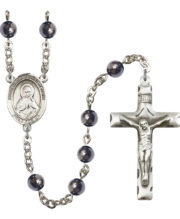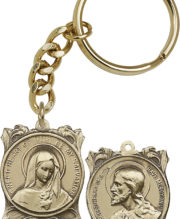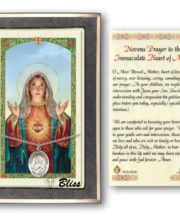Mary
Immaculate Heart of Mary
What is the devotion of the Immaculate Heart of Mary
The devotion to the Immaculate Heart of Mary is a spiritual practice within the Catholic Church that focuses on the devotion to the love, purity and compassion of Mary, the mother of Jesus. This devotion is rooted in the belief in the Immaculate Conception, the doctrine that Mary was conceived without original sin, and her role as the mother of Jesus, the Son of God, and the spiritual mother of all believers.
The devotion to the Immaculate Heart of Mary is rooted in the belief that Mary’s heart, as the mother of Jesus, is full of love, compassion, and purity. The imagery of the Immaculate Heart usually depicts a heart surrounded by flames, symbolizing Mary’s burning love for God and for humanity.
It is believed that the Immaculate Heart of Mary is a symbol of love and compassion, representing her role as a mother who cares for her children and intercedes for them to God. Devotees of the Immaculate Heart of Mary usually wear a medal or a pendant of the Immaculate Heart as a reminder of their devotion and as a source of inspiration to live according to the teachings of Mary and Jesus.
One of the most famous apparitions of the Immaculate Heart of Mary was the apparition of Fatima in 1917, where Mary is said to have appeared to three shepherd children, Lucia, Jacinta, and Francisco. In her apparitions, Mary called for devotion to her Immaculate Heart, asking for prayer and reparation, to prevent the outbreak of war and the spread of atheism.
The devotion to the Immaculate Heart of Mary includes various practices such as the recitation of the Rosary, the praying of the Chaplet of the Immaculate Heart, the reading of Scripture passages related to Mary and the celebration of liturgical feast days in honor of the Immaculate Heart.
In addition, the devotion to the Immaculate Heart of Mary is often associated with the devotion to the Sacred Heart of Jesus, the devotion to the human heart of Jesus, which reflects his love, mercy and compassion.
How to celebrate the feast of the Immaculate Heart of Mary
The Feast of the Immaculate Heart of Mary is typically celebrated on the Saturday immediately following the Feast of the Sacred Heart of Jesus, which is on the Friday after the Feast of Corpus Christi. This means that the Feast of the Immaculate Heart of Mary is typically celebrated on the second Saturday in June.
There are a variety of ways that the Feast of the Immaculate Heart of Mary can be celebrated, depending on one’s personal preferences and the resources available. Some ways to celebrate include:
-
Mass attendance: Many parishes will have a special Mass to commemorate the Feast of the Immaculate Heart of Mary.
-
Devotions and prayers: Many Catholics will choose to pray the rosary or recite other prayers dedicated to the Immaculate Heart of Mary.
-
Adoration of the Blessed Sacrament: Some Catholics may choose to spend time in adoration of the Blessed Sacrament as a way of honoring the Immaculate Heart of Mary.
-
Procession: Some parishes may organize a procession with a statue of Mary in honor of the Immaculate Heart of Mary.
-
Reflection and meditation: Many Catholics may choose to reflect on the teachings and messages associated with the Immaculate Heart of Mary, such as the importance of humility and devotion.
-
A special novena: Many Catholics may choose to pray a special novena in honor of the Immaculate Heart of Mary.
It is important to note that the celebration of the Feast of the Immaculate Heart of Mary is not a holy day of obligation, meaning Catholics are not obliged to attend Mass, but it is a special day to remember and honor Mary and her Immaculate Heart.
Are there scriptural roots of Immaculate Heart of Mary?
The scriptural basis for the doctrine of the Immaculate Heart of Mary is not explicitly stated in the Bible. However, certain scriptural passages are often cited as providing a foundation for the doctrine.
One of the most commonly cited passages is Luke 1:28, in which the angel Gabriel greets Mary with the words, “Hail, full of grace, the Lord is with you.” The phrase “full of grace” is translated from the Greek word “kecharitomene,” which is a perfect passive participle of “charitoo” meaning “filled with grace” and connotes a permanent state of grace. This passage is understood by some to indicate that Mary was free from original sin from the moment of her conception, which is one of the key aspects of the doctrine of the Immaculate Heart.
Another passage that is often cited is Luke 1:42, in which Mary’s cousin Elizabeth, upon seeing her, exclaims, “Blessed are you among women, and blessed is the fruit of your womb!” This is understood by some to indicate that Mary was set apart and chosen by God for a special purpose, which is also a key aspect of the doctrine of the Immaculate Heart.
Additionally, the Bible also speaks about Mary’s role as the mother of Jesus, who is the Son of God, and her association with Jesus’ redeeming work. In Revelation 12:1, Mary is depicted as a woman “clothed with the sun, with the moon under her feet, and on her head a crown of twelve stars.” This imagery is understood by some to symbolize Mary’s spiritual significance and her close association with Jesus.
It’s important to note that the doctrine of the Immaculate Heart of Mary is a teaching of the Catholic Church that was developed over time through theological reflection and Church tradition, rather than a teaching that is directly and explicitly stated in scripture.




